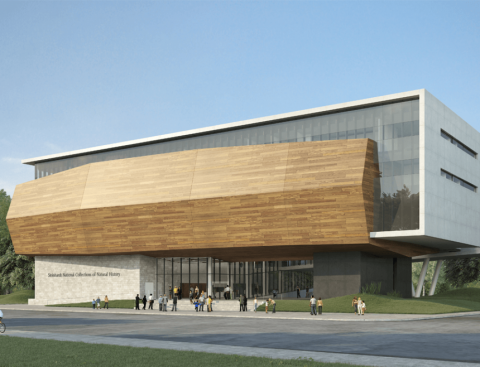New Natural History Museum in Tel-Aviv
The 8,000-square-meter building – which last week hosted the Fresh Paint art exhibition, but will officially open to the public in the summer – is said to be the largest, most comprehensive center in the region for biodiversity research, education and conservation. According to Tel Aviv University, it is “the first and only center for natural history research and outreach in the Middle East.”
Designed by Israeli firm Kimmel Eshkolot Architects, which won an international competition back in 2009, the Steinhardt Museum of Natural History contains a public section open to visitors, and a section for academic research intended for faculty and staff. According to architect Michal Kimmel-Eshkolot, “the building is designed to separate these two functions through different areas of activity, as well as different patterns of circulation.” Yet, in designated areas, the two functions meet “in a series of orchestrated vistas, which enrich the experience of the visitor and reveal the work of the scientists.”
The museum visit begins at the large entrance plaza overlooking Tel Aviv University’s botanical gardens. The building hovers over a series of terraces and provides shade for the visitors prior to entry. Inside the building, ramps lead the visitors along the different types of exhibits. Each ramp presents a different experience and is adapted to the architectural essence of the building. In this way, a visitor passes “from light to darkness, from open to enclosed spaces, and from small exhibits to diorama-type exhibits,” the architect said in a statement.
The museum was made possible by philanthropist, financier and investor Michael Steinhardt, one of the founding patrons of Birthright Israel. “I believe the five million plus specimens that will be in the museum on opening day are already a dynamic record of Israel’s biodiversity and the history and evolution of humankind in the Middle East,” Steinhardt said in a statement. “Through the museum, we have the opportunity to ensure that scientists, researchers and people of all stripes who are interested in preserving the past to better understand the future will have a place to observe and study that history for themselves.”
According to Stanford University’s Prof. Dr. Marcus Feldman, a member of the Steinhardt Museum International Scientific Advisory Board, “Israel is the crossroads at which all plants, animals and humans moved from Africa to Europe and Asia. It is the only place in the world where you can see this historical depth. In 10 or 20 years, the Steinhardt Museum will become a major world center for the study of biological systematics, evolution, paleo-ecology and paleo-anthropology.”
Einat Paz-Frankel

